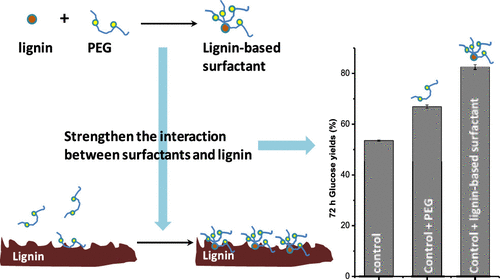当前位置:
X-MOL 学术
›
ACS Sustain. Chem. Eng.
›
论文详情
Our official English website, www.x-mol.net, welcomes your
feedback! (Note: you will need to create a separate account there.)
Incorporating Lignin into Polyethylene Glycol Enhanced Its Performance for Promoting Enzymatic Hydrolysis of Hardwood
ACS Sustainable Chemistry & Engineering ( IF 7.1 ) Pub Date : 2020-01-24 , DOI: 10.1021/acssuschemeng.9b05724 Chenhuan Lai 1 , Yuan Jia 1 , Chundong Yang 1 , Liwei Chen 1 , Hao Shi 2 , Qiang Yong 1, 3
ACS Sustainable Chemistry & Engineering ( IF 7.1 ) Pub Date : 2020-01-24 , DOI: 10.1021/acssuschemeng.9b05724 Chenhuan Lai 1 , Yuan Jia 1 , Chundong Yang 1 , Liwei Chen 1 , Hao Shi 2 , Qiang Yong 1, 3
Affiliation

|
Polyethylene glycol (PEG) has been widely applied to improve enzymatic hydrolysis of lignocellulose by reducing enzyme nonproductive binding on lignins. To improve the performance of PEG in enzymatic hydrolysis, lignin-based surfactants were synthesized through lignin graft modification with poly(ethylene glycol) diglycidyl ether in this study. More importantly, effects of incorporating lignin into PEG on its behavior in enzymatic hydrolysis were investigated. Enzymatic hydrolysis of poplar results indicated that lignin-based surfactants exhibited better performance compared to PEG for promoting enzymatic hydrolysis. Moreover, a lower lignin-based surfactant loading was needed to achieve equal enzymatic hydrolysis. To explore the potential mechanism, changes of enzyme distribution and residual enzyme activities in supernatant after adding surfactants were determined. Quartz crystal microbalance with dissipation analysis was used to monitor the interaction between surfactants/enzyme and lignin in real-time. It revealed that the binding rates of lignin-based surfactants on lignin surfaces (1.06–1.32 min–1) were higher than those of PEG (0.43 min–1). Additionally, lignin-based surfactants respectively reduced the enzyme binding rates and maximum enzyme binding capacity on lignin by 36.7–40.9% and 43.3–64.9%, which was more significant than the reduction in enzyme binding rates and maximum enzyme binding capacity with PEG. A better understanding of this beneficial mechanism is a benefit for the design and utilization of surfactant in the lignocellulosic biorefinery process.
中文翻译:

将木质素掺入聚乙二醇中可增强其促进硬木酶水解的性能
聚乙二醇(PEG)已被广泛应用于通过减少酶对木质素的非生产性结合来改善木质纤维素的酶促水解。为了提高PEG在酶促水解中的性能,本研究中通过木质素接枝改性与聚乙二醇二缩水甘油醚合成了木质素基表面活性剂。更重要的是,研究了将木质素掺入PEG对其在酶促水解中的行为的影响。杨树的酶促水解结果表明,与PEG相比,木质素表面活性剂表现出更好的促进酶促水解的性能。而且,需要较低的木质素基表面活性剂负载量以实现相等的酶水解。为了探索潜在的机制,测定加入表面活性剂后上清液中酶分布和残余酶活性的变化。带有耗散分析的石英晶体微量天平用于实时监测表面活性剂/酶与木质素之间的相互作用。结果表明,木质素表面活性剂在木质素表面的结合速率(1.06-1.32 min–1)高于PEG(0.43 min –1)。此外,基于木质素的表面活性剂分别降低了对木质素的酶结合率和最大酶结合能力,分别降低了36.7–40.9%和43.3–64.9%,这比降低PEG的酶结合率和最大酶结合能力更为显着。对这种有益机理的更好理解对木质纤维素生物精炼过程中表面活性剂的设计和利用是有益的。
更新日期:2020-01-24
中文翻译:

将木质素掺入聚乙二醇中可增强其促进硬木酶水解的性能
聚乙二醇(PEG)已被广泛应用于通过减少酶对木质素的非生产性结合来改善木质纤维素的酶促水解。为了提高PEG在酶促水解中的性能,本研究中通过木质素接枝改性与聚乙二醇二缩水甘油醚合成了木质素基表面活性剂。更重要的是,研究了将木质素掺入PEG对其在酶促水解中的行为的影响。杨树的酶促水解结果表明,与PEG相比,木质素表面活性剂表现出更好的促进酶促水解的性能。而且,需要较低的木质素基表面活性剂负载量以实现相等的酶水解。为了探索潜在的机制,测定加入表面活性剂后上清液中酶分布和残余酶活性的变化。带有耗散分析的石英晶体微量天平用于实时监测表面活性剂/酶与木质素之间的相互作用。结果表明,木质素表面活性剂在木质素表面的结合速率(1.06-1.32 min–1)高于PEG(0.43 min –1)。此外,基于木质素的表面活性剂分别降低了对木质素的酶结合率和最大酶结合能力,分别降低了36.7–40.9%和43.3–64.9%,这比降低PEG的酶结合率和最大酶结合能力更为显着。对这种有益机理的更好理解对木质纤维素生物精炼过程中表面活性剂的设计和利用是有益的。











































 京公网安备 11010802027423号
京公网安备 11010802027423号